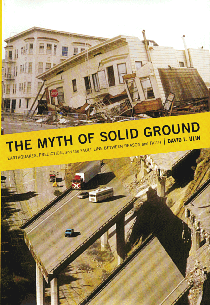How do we live in a world where the ground beneath our feet is not fixed?

By Beth Kephart | In January 2001, as I was finalizing a book that had taken me 15 years to research, shape, and write, a fever set in, a succession of nightmares. When I was asleep, I dreamed of earthquakes. When I was awake, I imagined them. They were coming, I felt sure, to the land that I’d been writing about, to El Salvador, my husband’s childhood home. They were coming, and I couldn’t stop them.
Whatever one might want to say about coincidence or fate, this much is true: On January 13, 2001, the first of a series of terrible temblors struck Santa Tecla, the Salvadoran city where my husband had been born, where many of his friends still lived, where his mother and her sisters and brother lived off of the increasingly scarce income of coffee farms. Entire neighborhoods were swallowed. Coffee trees slid off their slopes. Cathedrals fell, and banks were flattened, and there were no more flimsy marketplace stalls. People were gone, locked deep inside the earth; there were reports of children screaming beneath tons of fallen earth. History had been elided and erased. Parts of Santa Tecla’s past would never be resurrected.
Curse the earthquake, but then again, as David Ulin writes in The Myth of Solid Ground, our planet would be dead, a hard hot or cold stone, without the changes quakes both signify and yield. “A living planet is not fixed, but fluid,” Ulin says. “A living planet is always on the move. In some sense, you might even say that a living planet exists in a continual state of crisis, that this urgency, this insistence, is what defines it as alive.”
Still, how do we live in a world where the ground beneath our feet is not in fact fixed? Whom should one believe in the struggle to predict, or even accurately define, temblors? Is science superior to intuition? If we dream of earthquakes and earthquakes come, are we smart, or are we—well—surely you can’t call that lucky?
A resident of the infamously shaky state of California, a man who says he’s always thought in metaphors, Ulin, in Myth, sets for himself the telling of a story:
This is a story that takes place within that seismic landscape. It’s a story that begins and ends with an earthquake, a story about the way that, here in California, the soil we stand on can, without warning, turn as fluid as the sea. It’s a story about how, in the face of all that motion, we evolve elaborate strategies of protection, strategies that help us get on with our lives.
Like John McPhee, the writer he most frequently quotes throughout the book, Ulin’s prose style is lyrical and smooth, marked by long, clause-dependent sentences. Also like McPhee, Ulin is concerned with geopoetry, “where intuition, the ability to make connections, may be the most essential tool we have,” and his quest is highly personal. He seeks out answers to his metaphysical, scientific, and statistical questions by spending time in the company of scientists as well as characters whom I came to think of as earthquake folklorists, but who go by the name of “predictors” in this text.
Ulin writes frequently of his awe and his angst. He actively seeks out earthquake experiences (both the theme-park variety and the actual sort) on the one hand, and lives his life in eternal fear of real quakes on the other, chanting his mantra, Please, not here, not now, when entering, for example, underground subway tunnels. He recognizes how frustratingly anecdotal, contradictory, or coincidental earthquake history is, and yet, his “absolute favorite earthquake fact ever” is that the automobile accident that killed James Dean occurred at the Fort Tejon epicenter, “as if the location itself, the very crossroads, might be a kind of vortex, a magnet for our most enduring myths.”
The science is quite interesting in this book, even though, after eavesdropping on the various conversations Ulin has with the “experts” and “predictors,” one begins to share Ulin’s contention that scientific evidence or supposition should never be confused with an outright earthquake truth. Still, Ulin is not intent upon some fundamental, inviolable truth. He is intent upon living in an unstable world—of seeing beyond the ineluctable and temporary, of being connected with a longer geological history. “What I’m after,” he writes:
is an intuitive landscape, a place where truth and imagination coincide. I want to be transported by uncertainty, put in touch with the ineffable, while at the same time keeping my feet firmly on the ground. I want to occupy a territory somewhere between [researcher Allan] Lindh and [predictor Jim] Berkland, in which geopoetry opens up a passage to both understanding and wonder, and earthquakes make us larger than ourselves.
Can the ineffable and the actual peacefully coexist? Does uncertainty transport us? Are we alive because we live in constant danger? Read The Myth of Solid Ground and draw your own conclusions.
Beth Kephart C’82 is the author of Still Love in Strange Places, a memoir of El Salvador. Her fifth book, Ghosts in the Garden, is due out in March.




